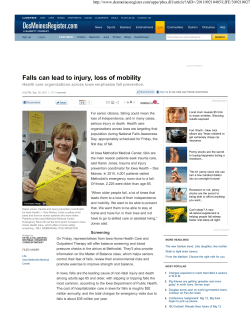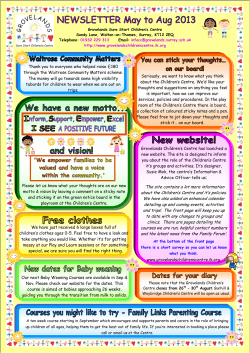
National Household Travel Survey Add-On Use in the Des Moines,... Presentation to the Transportation Research Board’s
National Household Travel Survey Add-On Use in the Des Moines, Iowa, Metropolitan Area Presentation to the Transportation Research Board’s National Household Travel Survey Conference: Data for Understanding our Nation’s Travel Prepared by: Tom Kane, Executive Director Des Moines Area Metropolitan Planning Organization Merle Hay Centre – 6200 Aurora Avenue, Suite 300W Urbandale, IA 50322-2866 Telephone (515) 334-0075 Facsimile (515) 334-0098 E-mail TJKane@dmampo.org INTRODUCTION The Des Moines Area Metropolitan Planning Organization (MPO) serves a Planning Area population of 395,174, from fifteen member cities and portions of three member counties. In 2000, the Des Moines Metropolitan Statistical Area (MSA) consisted of three central Iowa counties: Dallas, Polk, and Warren. At the time the opportunity to participate as an add-on to the 2001 National Household Travel Survey (NHTS) arose, the Des Moines Area MPO chose to purchase 1,200 NHTS Add-on surveys for a fourcounty area, the three counties in the Des Moines MSA plus one additional county expected to join the Des Moines MSA with the release of the 2000 U.S. Census data. Polk County, home of Iowa’s State Capitol and most populous city, Des Moines, accounted for 597 of the completed NHTS Add-on surveys. In Dallas County, the fastest growing county in the State of Iowa, 262 household surveys were completed. Households in Warren County completed 241 surveys, and 131 surveys were completed in Madison County. A total of 1231 NHTS Add-on household surveys were completed for the Des Moines Area MPO from June 2001 through June 2002. The expectation that the fourth county, Madison, would join the Des Moines MSA proved to be correct, verified by the release of the 2000 U.S. Census data. However, a fifth county, Guthrie, also joined the Des Moines MSA following the 2000 U.S. Census and was not accounted for in the 2001 NHTS Add-on. Before participation in the 2001 NHTS Add-on program, the last time the Des Moines area had collected extensive travel data was in the 1960’s. Much has changed in the Des Moines metropolitan area since the 1960’s and the 2001 NHTS Add-on data combined with the release of the 2000 U.S. Census data enabled the Des Moines Area MPO to update the true travel picture of the region. The Iowa Department of Transportation and the Des Moines Area MPO joined equally to purchase the 2001 NHTS Add-on data. This partnership means the ability to apply, share, and transfer the Des Moines metropolitan area NHTS Add-on data and statistics to the rest of the State of Iowa. NHTS ADD-ON DATA USE Travel Demand Modeling An important, essential use of the 2001 NHTS Add-on data in the Des Moines metropolitan area is the survey’s input in the Des Moines Area MPO’s Travel Demand Model. Querying the 7,506 Vehicle Trips from the Access database NHTS data to discern Non-Home Based, Home Based Other, and Home Based Work trip percentages is valuable to assigning trip types to the Travel Demand Model. An expected result from the trip type queries was that Non-Home Based trips per household in the Des Moines metropolitan area would rise, resulting from increased trip-chaining by the traveling public, from the data currently used in the Travel Demand Model. This phenomenon, however, was not found to be the case. NonHome Based trip rates did not change significantly in the 2001 NHTS Add-on data over the previous Travel Demand Model inputs, proving that the Des Moines Area MPO in its Travel Demand Modeling efforts had been accounting for Non-Home Based trips, and trip-chaining activities, adequately, thus validating the current input methodologies. Home-Based Other and Home-Based Work trip percentages, derived from the 2001 NHTS Add-on data, both increased over the previous Travel Demand Model input. The Des Moines Area MPO staff used the 2001 NHTS Add-on data to update cross-classification trip rates, using household size and the number of automobiles owned. The data showed smaller households sizes and more vehicles per household than had previously been observed. All new trip type percentages and cross-classification rates from the 2001 NHTS Add-on survey data were incorporated into the calibration of the Des Moines Area MPO’s Travel Demand Model for use in the creation of the Year 2030 Long-Range Transportation Plan. 1 An additional comparison useful for validating the Des Moines Area MPO’s Travel Demand Model was transit usage by the traveling public. The Des Moines Area MPO does not conduct Mode Choice Modeling. NHTS Add-on data was able to assist the Des Moines Area MPO in determining whether Mode Choice Modeling would be a valuable use of time and resources. Transit usage accounted for less than one percent of the total trips, according to the 2001 NHTS Add-on data. Based on the 2001 NHTS Addon survey data, it was decided that at the present time transit usage was not a large enough percentage of total trips to warrant the creation of a Mode Choice Model. Travel Time Survey The Des Moines Area MPO annually conducts a Travel Time Survey as part of its Transportation Management Area Congestion Management System. Four to five routes exhibiting peak hour congestion at Level of Service D or greater are selected each year for the Travel Time Survey. The Des Moines Area MPO staff drives each route on three consecutive days, Tuesday through Thursday, at peak travel times, morning and afternoon/evening. The days Tuesday, Wednesday, and Thursday were chosen as they have historically been the most ‘typical’ travel days of the week. The Travel Time Survey is conducted either in the spring or in the fall, when school is in session. The purpose of the Travel Time Survey is to determine the amount of time, an indicator of congestion, it takes to drive from point A to point B along a route. Historical data can be analyzed to determine if construction projects completed along the route, meant to reduce congestion, reduced the travel time for commuters and others traveling the corridor. The 2001 NHTS Add-on data for the four-county central Iowa area, however, shows a different travel pattern than the historical data. The most heavily traveled three days of the week in terms of vehicle trips are Tuesday, with 17.4 percent vehicle trips, Monday, with 15.8 percent vehicle trips, and Friday, with 15.0 percent vehicle trips. The remaining four days of the week rated as follows: Saturday, with 14.6 percent; Wednesday, with 13.2 percent; Sunday, with 12.2 percent; and, Thursday, with 11.8 percent. Comparing vehicle trips to person trips from the 2001 NHTS Add-on data, the rankings change slightly. Saturday rated highest among person trip days, with 16.1 percent, Tuesday was second, with 15.8 percent, and Sunday was third, with 15.4 percent. The remaining four days of the week rated as follows: Monday, with 15.3 percent person trips; Friday, with 14.1 percent person trips; Wednesday, with 12.3 percent person trips; and, Thursday, with 11.1 percent person trips. As shown by the 2001 NHTS Add-on data, the days persons most typically travel are the weekend days and Tuesdays. While the rankings by day do shift from vehicle trips to person trips, Wednesday and Thursday are not among the three most heavily, or typically, traveled days of the week in either category. Traditionally, the Des Moines Area MPO’s Travel Time Survey is conducted during the peak travel times equating to the morning and evening commutes. The Travel Time Survey is conducted from 6:30 a.m. to 8:30 a.m. and from 4:00 p.m. to 6:00 p.m., repeating routes every half hour. The 2001 NHTS Add-on data, however, has shown the peak travel times differing from those used during the Travel Time Survey. In terms of person trips, the afternoon/evening commute is the most heavily traveled time of day. The hour between 3:00 p.m. and 4:00 p.m. is the most traveled in terms of person trips, with 9.1 percent traveling during this hour. Ranking second in percentage of person trips is the hour between 4:00 p.m. and 5:00 p.m. with 9.0 percent, and 5:00 p.m. to 6:00 p.m. ranking third with 8.9 percent. Lunchtime hours, from 11:00 a.m. to 12:00 p.m. and 12:00 p.m. to 1:00 p.m., rank fourth (8.1 percent) and fifth (7.3 percent), respectively. Surprisingly, according to the 2001 NHTS Add-on data, the morning commute hours of 7:00 a.m. to 8:00 a.m. and 8:00 a.m. to 9:00 a.m. rank sixth (7.3 percent) and eleventh (5.0 percent), respectively, in terms of person trips. 2 The spring and fall seasons are chosen to conduct the Travel Time Survey to avoid times in the winter and summer when persons may have time off for holidays and vacations and when children may have time off from school. The weather also is more temperate during the spring and fall seasons allowing the routes to be surveyed under ‘normal’ driving conditions. From the 2001 NHTS Add-on data, however, it is shown that several of the peak travel months are in the summer and winter. In ranking order, the most heavily traveled months, in terms of vehicle trips, are as follows: 1. 2. 3. 4. 5. 6. 7. 8. 9. 10. 11. 12. August, 11.7 percent October, 10.2 percent December, 10.0 percent November, 9.8 percent January, 9.6 percent September, 9.6 percent July, 9.5 percent March, 8.0 percent April, 7.9 percent February, 5.5 percent June, 4.1 percent May, 4.1 percent Likewise, for person trips, several of the peak travel months occur in the summer and winter seasons. In ranking order, the most heavily traveled months, in terms of person trips, are as follows: 1. 2. 3. 4. 5. 6. 6. 8. 9. 10. 11. 12. August, 12.3 percent December, 10.9 percent October, 10.5 percent September, 10.2 percent July, 9.9 percent January, 9.3 percent November, 9.3 percent March, 7.4 percent April, 7.3 percent February, 5.3 percent June, 3.8 percent May, 3.7 percent Based on this 2001 NHTS Add-on information, with ‘typical’ travel days shifted from Wednesday and Thursday to other days of the week, peak travel times not centered as much around morning work commute times, and heavy travel months not necessarily occurring in the spring and fall seasons, the Des Moines Area MPO will re-evaluate the use of and timing of the Travel Time Survey in the future. General Travel Information Household, Person, and Vehicle Data In the four county survey area, 1231 households were surveyed for the 2001 NHTS Add-on effort, equating to 184,740 households after weighting. Likewise, persons surveyed equaled 2,986, for a weighted total of 470,041 persons residing in the four counties. The 2001 NHTS Add-on data reported 2.5 persons per household. Of those 2.5 persons per household, 1.9 are drivers aged 15 years or older. From the total population, 93.9 percent of persons aged 15 years and older are reported as drivers. 3 Each household averages 2.1 vehicles, meaning there are more vehicles than drivers in the Des Moines metropolitan area. This finding corresponds with the national 2001 NHTS, which reported 1.8 drivers per household and 1.9 vehicles per household.1 Affluence and household size affects the number of vehicles per household. For example, the average number of vehicles owned by a household of two is 2.2, while the average number of vehicles owned by a household of six is 3.3. Table 1 shows the four county average number of vehicles by household size. Table 1 Household Size Average Number of Vehicles 1.3 2.2 2.7 2.5 2.5 3.3 2.7 1 2 3 4 5 6 7+ Household income also is a determining factor for the number of vehicles the household can access. For example, households earning $20,001 to $25,000 average 1.5 vehicles, households earning $60,001 to $65,000 average 2.4 vehicles, and households more than $100,000 annually average 2.6 vehicles. Table 2 shows the average number of vehicles by household income level. Average number of vehicles per household peaked at the $65,001 to $70,000 income level, with 2.7 vehicles. Table 2 Household Income Less Than $5,000 $5,001 to $10,000 $10,001 to $15,000 $15,001 to $20,000 $20,001 to $25,000 $25,001 to $30,000 $30,001 to $35,000 $35,001 to $40,000 $40,001 to $45,000 $45,001 to $50,000 $50,001 to $55,000 $55,001 to $60,000 $60,001 to $65,000 $65,001 to $70,000 $70,001 to $75,000 $75,001 to $80,000 $80,001 to $100,000 More Than $100,000 Average Number of Vehicles 1.8 1.1 1.4 1.5 1.5 1.8 1.8 2.1 2.1 2.1 2.2 2.4 2.4 2.7 2.6 2.4 2.6 2.6 1 http://www.bts.gov/publications/national_household_travel_survey/highlights_of_the_2001_national_household_travel_survey/html /section_01.html, accessed September 28, 2004 4 Household income affects the age of the vehicles owned, as well. Table 3 shows the average model year of vehicles by household income level. Not surprisingly, as household income levels rose so did the average model year of the vehicles used by the household. What was slightly surprising is that the average model years were not showing years later than 1995. The data for this survey effort was collected from June 2001 through June 2002, meaning the average vehicle was approximately six years old, at a minimum. This data finding is consistent with the national 2001 NHTS, which revealed vehicles in households with an income of $100,000 or more averaged a model year of 1996, and households with an income of less than $25,000 had an average model year of 1991.2 Table 3 Household Income Less Than $5,000 $5,001 to $10,000 $10,001 to $15,000 $15,001 to $20,000 $20,001 to $25,000 $25,001 to $30,000 $30,001 to $35,000 $35,001 to $40,000 $40,001 to $45,000 $45,001 to $50,000 $50,001 to $55,000 $55,001 to $60,000 $60,001 to $65,000 $65,001 to $70,000 $70,001 to $75,000 $75,001 to $80,000 $80,001 to $100,000 More Than $100,000 Average Model Year of Vehicles 1992 1989 1992 1989 1990 1992 1992 1992 1992 1992 1993 1993 1993 1993 1993 1993 1994 1995 The number of person trips per day averaged 3.9. Females made an average 4.2 trips per day and males averaged 3.8 trips per day. Age, rather than gender, had a greater effect on number of daily trips. Persons aged 45 to 54 averaged 4.9 trips per day, making the greatest number of trips per day of any age cohort, while those aged 65 and older averaged only 3.7 trips per day, making the least number of trips per day of any age cohort. Table 4 shows the average number of daily trips per person by age cohort. Those age groups averaging more than four trips per day would likely have work, social activities, and children’s activities increasing the number of daily trips over the other age cohorts. Table 4 Age Cohort 15 to 24 25 to 34 35 to 44 45 to 54 55 to 64 65 and older Average Number of Daily Trips per Person 3.8 4.1 4.5 4.9 3.9 3.7 2 http://www.bts.gov/publications/national_household_travel_survey/highlights_of_the_2001_national_household_travel_survey/html /section_01.html, Accessed September 27, 2004 5 Average Trip Lengths An example of other general travel information determined from the 2001 NHTS Add-on data was that the mileage persons travel to work or social/recreational activities is longer than the mileage persons travel to run errands or obtain services. This would indicate that persons are willing to travel to reach their workplace or a social activity, but would rather do business closer to home or work for shopping and services. The average work trip length in the Des Moines metropolitan area is 10.7 miles and the average social/recreational trip length is 13.2 miles. Shopping/errand trips are an average 5.6 miles and medical/dental services trips are approximately 7.3 miles in length. By comparison, the average length of all trips is 8.3 miles. Clustering service type businesses around large corporate locations and housing developments could prove appealing to persons when selecting a home or workplace. Housing and workplace proximity are not necessarily deciding factors, however, when choosing those respective locations. Further research could be done on this topic to determine if mileage between work and home is not as important as other factors when choosing a residence and if this happens by choice or by chance. Vehicle Occupancies Vehicle occupancies are higher for social/recreational activities (2.3 persons) and errand trips (1.8 persons) than for work trips (1.4 persons). This phenomenon is not surprising. Families or friends tend to go to social/recreational activities or run errands together, where persons are more likely to drive alone to work. Annual Vehicle Mileage Of those vehicle owners knowledgeable of miles vehicles are driven annually, the majority of vehicles (61.4 percent) were driven fewer than 10,000 miles annually. More specifically, vehicles driven 5,000 miles or less totaled 35.5 percent and vehicles driven 5,001 through 10,000 miles totaled 25.8 percent. Other mileage percentages of note include: 10,001 to 15,000 annual miles driven, 22.2 percent; 15,001 to 20,000 annual miles driven, 8.3 percent; and, more than 20,000 annual miles driven, 8.1 percent. According to the U.S. Environmental Protection Agency, the average annual miles nationally for a passenger car is 12,500 miles and for a light truck is 14,000 miles.3 Therefore, with a majority of vehicles driven under 10,000 miles annually, the Des Moines metropolitan area is below the national average. Accounting for this fact may be the age of the population in the Des Moines metropolitan area and/or the compactness of the region. As explained earlier, average work trips and shopping/errand trips average only 10.7 miles and 5.6 miles, respectively. The services and employment opportunities the general population requires are all available in a compact area, with the Des Moines Area MPO Planning Area measuring only 499.7 square miles. Thus, there is not a need by the majority of the vehicles to be driven greater than 10,000 miles annually. The State of Iowa ranks fourth in terms of the percent of total population aged 65 and over.4 According to the 2001 NHTS Add-on data, the average age in the four county central Iowa survey area was 34.4 years. These older populations tend to drive less than younger populations. As an example, the percentage of travel day vehicle miles traveled by the 21- to 25-age cohort was 3.6 percent, while the 71- to 75-age cohort traveled 2.0 percent of the travel day vehicle miles. Vehicle Type The majority (56.2 percent) of household vehicles owned in the four-county survey area were automobiles/cars/station wagons with pickup trucks a distant second place (16.0 percent). Combined, sport utility vehicles and vans were 23.9 percent of the total household vehicles owned. 3 4 http://www.epa.gov/otaq/consumer/f00013.htm, accessed September 27, 2004 http://www.prb.org/Template.cfm?Section=PRB&template=/ContentManagement/ContentDisplay.cfm&ContentID=8429, accessed September 27, 2004 6 Work Trips Work trips made by public transit/commuter/school bus amounted to 1.1 percent of total work trips, while work trips made by car/sport utility vehicle/van/pickup truck amounted to 93.2 percent of total work trips. By comparison, walking accounted for 4.2 percent of work trips in the four county area. CONCLUSION All of the statistics detailed in the 2001 NHTS Add-on survey data add up to create a profile for the Des Moines metropolitan area’s travel pattern. Obtaining the 1,200 surveys through the 2001 NHTS Add-on program painted a picture of travel on the transportation system which caused the Des Moines Area MPO to be more aware of the travel patterns existing in the Planning Area. The Des Moines Area MPO found the NHTS Add-on survey to be a useful data set in calibrating and validating the Travel Demand Model and in offering an accurate description of travel in the Des Moines, Iowa metropolitan area. The data determined by the 2001 NHTS Add-on was vital in updating the Des Moines Area MPO’s Travel Demand Model inputs. Trip type rates and household sizes and number of vehicles owned all were able to be discerned from the 2001 NHTS Add-on data allowing the travel demand modeling process to more accurately reflect a true picture of travel in the Des Moines metropolitan area. Using the outputs from the Travel Demand Model and the peak travel time data from the 2001 NHTS Add-on will enable the Des Moines Area MPO staff to reevaluate the use of and timing of the Travel Time Survey. Coupling those two data sources demonstrates where and when the congestion is occurring in the Des Moines metropolitan area and new routes and peak hour travel times may be determined from this data. To begin observing travel habits in a more trendline view and realizing the value of this information, the Des Moines Area MPO hopes to participate in the NHTS Add-on program to be conducted around the year 2010. 7
© Copyright 2025









